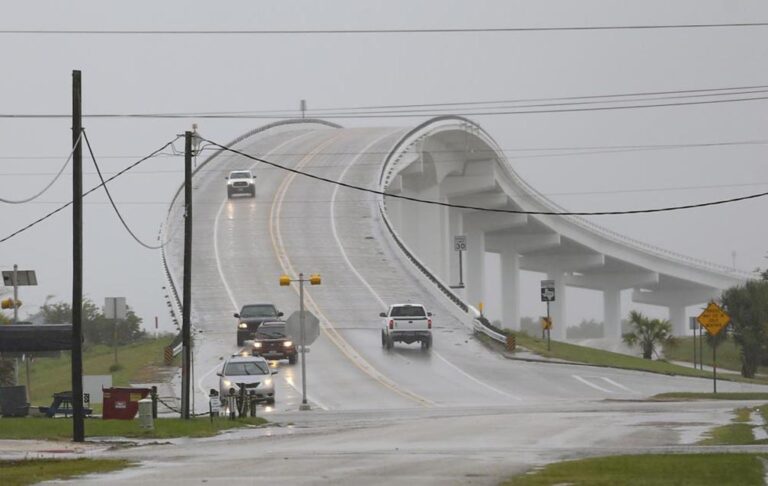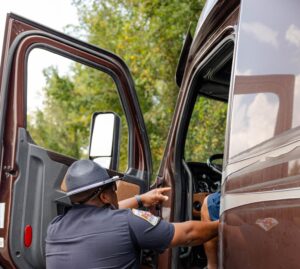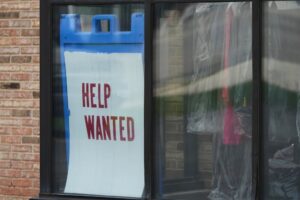HOUSTON — Tropical Storm Nicholas hit the Texas coast early Tuesday, Sept. 14, as a hurricane and dumped more than a foot of rain along the same area swamped by Hurricane Harvey in 2017, drenching storm-battered Louisiana, knocking out power to hundreds of thousands of people and bringing the potential for life-threatening flash floods across the Deep South.
Nicholas made landfall on the eastern part of the Matagorda Peninsula and was soon downgraded to a tropical storm. It was about 15 miles south-southwest of Houston, with maximum winds of 60 mph as of 7 a.m. CDT Tuesday, according to the National Hurricane Center in Miami. Nicholas was the 14th named storm of the 2021 Atlantic hurricane season.
Galveston, Texas, saw nearly 14 inches of rain from Nicholas, while Houston reported more than 6 inches of rain — a fraction of what fell during Harvey, which dumped more than 60 inches of rain in southeast Texas over a four-day period.
Nicholas is moving so slowly it will dump several inches of rain as it crawls over Texas and southern Louisiana, meteorologists said. This includes areas already struck by Hurricane Ida and devastated last year by Hurricane Laura. Parts of Louisiana are saturated with nowhere for the extra water to go, so it will flood, said University of Miami hurricane researcher Brian McNoldy.
“It’s stuck in a weak steering environment,” McNoldy said Tuesday. So, while the storm itself may weaken “that won’t stop the rain from happening. Whether it’s a tropical storm, tropical depression or post-tropical blob, it’ll still rain a lot and that’s not really good for that area.”
The storm was moving north-northeast at 8 mph, and the center of Nicholas was expected to move slowly over southeastern Texas on Tuesday and over southwestern Louisiana on Wednesday.
Nicholas, expected to weaken into a tropical depression by Wednesday, and could dump up to 20 inches of rain in parts of central and southern Louisiana.
Much of Texas’ coastline was under a tropical storm warning that included potential flash floods and urban flooding. Texas Gov. Greg Abbott said authorities placed rescue teams and resources in the Houston area and along the coast.
In Houston, officials worried that heavy rain could inundate streets and flood homes. Authorities deployed high-water rescue vehicles throughout the city and erected barricades at more than 40 locations that tend to flood, Mayor Sylvester Turner said Monday.
“This city is very resilient. We know what we need to do. We know about preparing,” said Turner, referencing four major flood events that have hit the Houston area in recent years, including devastating damage from Harvey.
Meteorologist Kent Prochazka of the National Weather Service told The Associated Press early Tuesday that Nicholas’ winds downed trees in coastal counties and caused some gas stations to lose awnings.
“Right before it made landfall, it abruptly intensified into a hurricane and as it moved inland, the pressures began to rise with it. The winds have relaxed slightly and now we’re getting down into tropical storm force (winds),” he said.
CenterPoint Energy reported that over 450,000 customers were without power as the storm rolled through Houston.
Numerous school districts along the Texas Gulf Coast canceled classes Monday and Tuesday because of the storm. The weather threat also closed multiple COVID-19 testing and vaccination sites in the Houston and Corpus Christi areas and forced the cancellation of a Harry Styles concert scheduled for Monday evening in Houston.
A tornado or two may be possible Tuesday along the upper Texas and southwest Louisiana coast, according to the weather service.
Nicholas brought rain to the same area of Texas that was hit hard by Harvey, which was blamed for at least 68 deaths, including 36 in the Houston area. After Harvey, voters approved the issuance of $2.5 billion in bonds to fund flood-control projects, including the widening of bayous. The 181 projects designed to mitigate damage from future storms are at different stages of completion.
McNoldy, the hurricane researcher, said Nicholas is bringing far less rain than Harvey did.
“It’s not crazy amounts of rain. It isn’t anything like Hurricane Harvey kind of thing with feet of rain,” McNoldy said. Harvey not only stalled for three days over the same area; it moved a bit back into the Gulf of Mexico, allowing it to recharge with more water. Nicholas won’t do that.”
Louisiana Gov. John Bel Edwards declared a state of emergency Sunday night, ahead of the storm’s arrival in a state.
On Monday, Misty Tran dreaded the thought of Nicholas reaching as far east as her home south of New Orleans in Empire, Louisiana. Ida damaged the roof of Tran’s mobile home. A tarp covers the roof now, Tran said, but it wouldn’t be a match for even a weak storm.
“A tarp can only do so much,” said Tran, helping clean up at a marina where she works.
The storm was expected to bring the heaviest rainfall west of where Ida slammed into Louisiana two weeks ago. Ida has been blamed for 86 deaths throughout the United States. Across Louisiana, about 93,000 customers remained without power Tuesday morning, according to the utility tracking site poweroutage.us.
Colorado State University hurricane researcher Phil Klotzbach said via Twitter that only four other years since 1966 have had 14 or more named storms by Sept. 12 — 2005, 2011, 2012 and 2020.
By Juan A. Lozano. Associated Press writers Jill Bleed in Little Rock, Arkansas; Jay Reeves in Empire, Louisiana; Julie Walker in New York; and AP Science Writer Seth Borenstein in Washington contributed to this report.
The Associated Press is an independent global news organization dedicated to factual reporting. Founded in 1846, AP today remains the most trusted source of fast, accurate, unbiased news in all formats and the essential provider of the technology and services vital to the news business. The Trucker Media Group is subscriber of The Associated Press has been granted the license to use this content on TheTrucker.com and The Trucker newspaper in accordance with its Content License Agreement with The Associated Press.














